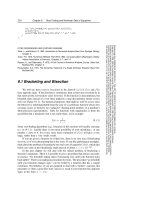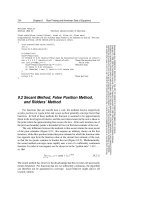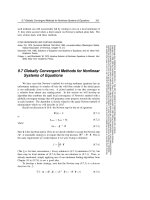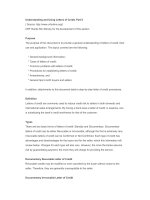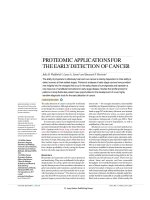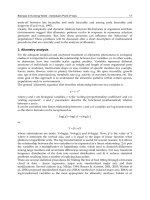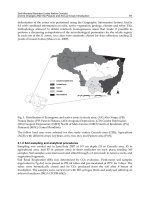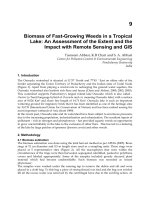Chapter 078. Prevention and Early Detection of Cancer (Part 2) ppt
Bạn đang xem bản rút gọn của tài liệu. Xem và tải ngay bản đầy đủ của tài liệu tại đây (46.3 KB, 5 trang )
Chapter 078. Prevention and Early
Detection of Cancer
(Part 2)
Physical Activity
Physical activity is associated with a decreased risk of colon and breast
cancer. A variety of mechanisms have been proposed. However, such studies are
prone to confounding factors such as recall bias, association of exercise with other
health-related practices, and effects of preclinical cancers on exercise habits
(reverse causality). Recommending adults to engage in at least 30 min of vigorous
activity for ≥3 days a week is good health advice, though its effects on cancer
incidence are unproven.
Diet Modification
International epidemiologic studies suggest that diets high in fat are
associated with increased risk for cancers of the breast, colon, prostate, and
endometrium. These cancers have their highest incidence and mortalities in
western culture where fat comprises an average of 40–45% of the total calories
consumed. In populations at low risk for these cancers, fat accounts for <20% of
dietary calories.
Despite correlations, dietary fat has not been proven to cause cancer. Case-
control and cohort epidemiologic studies give conflicting results. In addition, diet
is a highly complex exposure to many nutrients and chemicals. Low-fat diets are
associated with many dietary changes beyond simple subtraction of fat. Other
lifestyle changes are also associated with adherence to a low-fat diet. The
Women's Intervention Nutrition Study (WINS) evaluated the effects of low-fat
diet on breast cancer recurrence in previously treated postmenopausal breast
cancer patients. Breast cancer patients, mean age 62 years, were randomly
assigned to a standard diet (40% fat) or a low-fat diet (26% fat). At 5 years, breast
cancer had recurred in 9.8% of women in the low-fat diet group compared to
12.4% of women on the standard diet.
In observational studies, dietary fiber lowers the risk of colonic polyps and
invasive cancer of the colon. However, cancer protective effects of increasing
fiber and lowering dietary fat have not been proven in the context of a prospective
clinical trial. The putative protective mechanisms are complex and speculative.
Fiber binds oxidized bile acids and generates soluble fiber products, such as
butyrate, that may have differentiating properties. Fiber does not increase bowel
transit times. High-fiber diets could lower the risk of breast and prostate cancer by
absorbing and inactivating dietary estrogenic and androgenic cancer promoters.
However, two large prospective cohort studies of >100,000 health professionals
showed no association between fruit and vegetable intake and risk of cancer.
The Polyp Prevention Trial randomly assigned 2000 elderly persons, who
had polyps removed, to a low-fat, high-fiber diet versus routine diet for 4 years.
No differences were noted in polyp formation.
The U.S. National Institutes of Health Women's Health Initiative, launched
in 1994, is a long-term clinical trial enrolling >100,000 women aged 45–69. It
placed women in 22 intervention groups. Participants received calcium/vitamin D
supplementation, hormone-replacement therapy, and counseling to increase
exercise, eat a low-fat diet, and cease smoking. The study showed that while
dietary fat intake was significantly lower in the diet intervention group, invasive
breast cancers were not reduced over an 8-year follow-up period compared to the
control group. The difference in dietary fat averaged ~10% between the two
groups. Scientific evidence does not currently establish the anticarcinogenic value
of vitamin, mineral, or nutritional supplements in amounts greater than those
provided by a balanced diet. However, consuming at least five servings of fruits
and vegetables a day decreases dietary fat and increases fiber; such a diet may
lower the risk of cardiovascular disease even if it does not influence cancer.
Energy Balance
Risk of cancer increases as body mass index increases over 25 kg/m
2
.
Obesity increases risks for cancers of the colon, breast (female postmenopausal),
endometrium, kidney (renal cell), and esophagus, although causality is not
established.
Relative risks of colon cancer are increased in obesity by 1.5–2.0 for men
and 1.2–1.5 for women. Obese postmenopausal women have a 30–50% increased
risk of breast cancer. A hypothesis for the association is that adipose tissue serves
as a depot for aromatase that facilitates estrogen production. Adiposity is also
associated with poorer survival and increased risk of recurrence after treatment.
Sun Avoidance
Nonmelanoma skin cancers (basal cell and squamous cell) are induced by
cumulative exposure to ultraviolet (UV) radiation. Intermittent acute sun exposure
and sun damage have been linked to melanoma. Sunburns, especially in childhood
and adolescence, are associated with increased risk of melanoma in adulthood.
Reduction of sun exposure through use of protective clothing and changing
patterns of outdoor activities can reduce skin cancer risk. Sunscreens decrease the
risk of actinic keratoses, the precursor to squamous cell skin cancer, but melanoma
risk may be increased. Sunscreens prevent burning, but they may encourage more
prolonged exposure to the sun and may not filter out wavelengths of energy that
cause melanoma.
Educational interventions to help individuals accurately assess their risk of
developing skin cancer have some impact. Self examination for skin pigment
characteristics associated with melanoma, such as freckling, may be useful in
identifying people at high risk. Those who recognize themselves as being at risk
tend to be more compliant with sun-avoidance recommendations. Risk factors for
melanoma include a propensity to sunburn, a large number of benign melanocytic
nevi, and atypical nevi.
